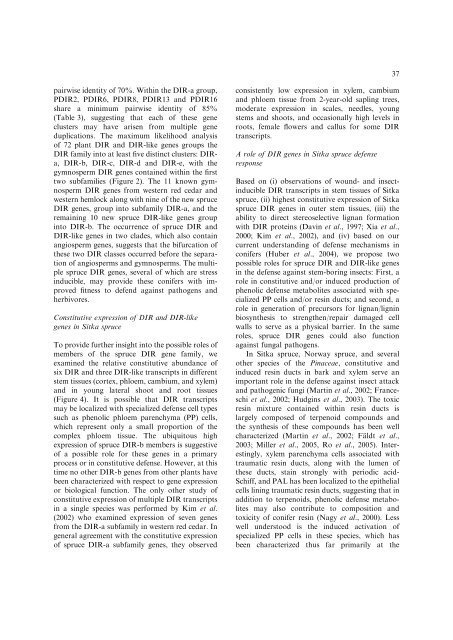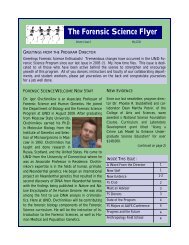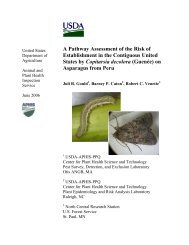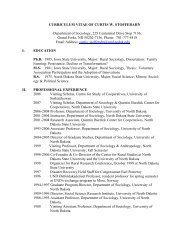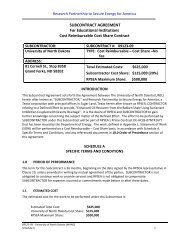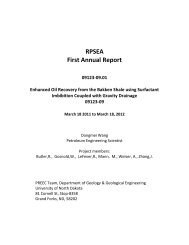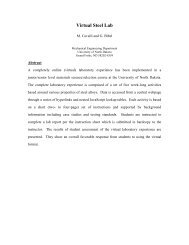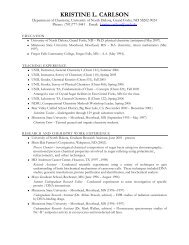Dirigent proteins in conifer defense: gene discovery, phylogeny, and ...
Dirigent proteins in conifer defense: gene discovery, phylogeny, and ...
Dirigent proteins in conifer defense: gene discovery, phylogeny, and ...
You also want an ePaper? Increase the reach of your titles
YUMPU automatically turns print PDFs into web optimized ePapers that Google loves.
37<br />
pairwise identity of 70%. With<strong>in</strong> the DIR-a group,<br />
PDIR2, PDIR6, PDIR8, PDIR13 <strong>and</strong> PDIR16<br />
share a m<strong>in</strong>imum pairwise identity of 85%<br />
(Table 3), suggest<strong>in</strong>g that each of these <strong>gene</strong><br />
clusters may have arisen from multiple <strong>gene</strong><br />
duplications. The maximum likelihood analysis<br />
of 72 plant DIR <strong>and</strong> DIR-like <strong>gene</strong>s groups the<br />
DIR family <strong>in</strong>to at least five dist<strong>in</strong>ct clusters: DIRa,<br />
DIR-b, DIR-c, DIR-d <strong>and</strong> DIR-e, with the<br />
gymnosperm DIR <strong>gene</strong>s conta<strong>in</strong>ed with<strong>in</strong> the first<br />
two subfamilies (Figure 2). The 11 known gymnosperm<br />
DIR <strong>gene</strong>s from western red cedar <strong>and</strong><br />
western hemlock along with n<strong>in</strong>e of the new spruce<br />
DIR <strong>gene</strong>s, group <strong>in</strong>to subfamily DIR-a, <strong>and</strong> the<br />
rema<strong>in</strong><strong>in</strong>g 10 new spruce DIR-like <strong>gene</strong>s group<br />
<strong>in</strong>to DIR-b. The occurrence of spruce DIR <strong>and</strong><br />
DIR-like <strong>gene</strong>s <strong>in</strong> two clades, which also conta<strong>in</strong><br />
angiosperm <strong>gene</strong>s, suggests that the bifurcation of<br />
these two DIR classes occurred before the separation<br />
of angiosperms <strong>and</strong> gymnosperms. The multiple<br />
spruce DIR <strong>gene</strong>s, several of which are stress<br />
<strong>in</strong>ducible, may provide these <strong>conifer</strong>s with improved<br />
fitness to defend aga<strong>in</strong>st pathogens <strong>and</strong><br />
herbivores.<br />
Constitutive expression of DIR <strong>and</strong> DIR-like<br />
<strong>gene</strong>s <strong>in</strong> Sitka spruce<br />
To provide further <strong>in</strong>sight <strong>in</strong>to the possible roles of<br />
members of the spruce DIR <strong>gene</strong> family, we<br />
exam<strong>in</strong>ed the relative constitutive abundance of<br />
six DIR <strong>and</strong> three DIR-like transcripts <strong>in</strong> different<br />
stem tissues (cortex, phloem, cambium, <strong>and</strong> xylem)<br />
<strong>and</strong> <strong>in</strong> young lateral shoot <strong>and</strong> root tissues<br />
(Figure 4). It is possible that DIR transcripts<br />
may be localized with specialized <strong>defense</strong> cell types<br />
such as phenolic phloem parenchyma (PP) cells,<br />
which represent only a small proportion of the<br />
complex phloem tissue. The ubiquitous high<br />
expression of spruce DIR-b members is suggestive<br />
of a possible role for these <strong>gene</strong>s <strong>in</strong> a primary<br />
process or <strong>in</strong> constitutive <strong>defense</strong>. However, at this<br />
time no other DIR-b <strong>gene</strong>s from other plants have<br />
been characterized with respect to <strong>gene</strong> expression<br />
or biological function. The only other study of<br />
constitutive expression of multiple DIR transcripts<br />
<strong>in</strong> a s<strong>in</strong>gle species was performed by Kim et al.<br />
(2002) who exam<strong>in</strong>ed expression of seven <strong>gene</strong>s<br />
from the DIR-a subfamily <strong>in</strong> western red cedar. In<br />
<strong>gene</strong>ral agreement with the constitutive expression<br />
of spruce DIR-a subfamily <strong>gene</strong>s, they observed<br />
consistently low expression <strong>in</strong> xylem, cambium<br />
<strong>and</strong> phloem tissue from 2-year-old sapl<strong>in</strong>g trees,<br />
moderate expression <strong>in</strong> scales, needles, young<br />
stems <strong>and</strong> shoots, <strong>and</strong> occasionally high levels <strong>in</strong><br />
roots, female flowers <strong>and</strong> callus for some DIR<br />
transcripts.<br />
A role of DIR <strong>gene</strong>s <strong>in</strong> Sitka spruce <strong>defense</strong><br />
response<br />
Based on (i) observations of wound- <strong>and</strong> <strong>in</strong>sect<strong>in</strong>ducible<br />
DIR transcripts <strong>in</strong> stem tissues of Sitka<br />
spruce, (ii) highest constitutive expression of Sitka<br />
spruce DIR <strong>gene</strong>s <strong>in</strong> outer stem tissues, (iii) the<br />
ability to direct stereoselective lignan formation<br />
with DIR <strong>prote<strong>in</strong>s</strong> (Dav<strong>in</strong> et al., 1997; Xia et al.,<br />
2000; Kim et al., 2002), <strong>and</strong> (iv) based on our<br />
current underst<strong>and</strong><strong>in</strong>g of <strong>defense</strong> mechanisms <strong>in</strong><br />
<strong>conifer</strong>s (Huber et al., 2004), we propose two<br />
possible roles for spruce DIR <strong>and</strong> DIR-like <strong>gene</strong>s<br />
<strong>in</strong> the <strong>defense</strong> aga<strong>in</strong>st stem-bor<strong>in</strong>g <strong>in</strong>sects: First, a<br />
role <strong>in</strong> constitutive <strong>and</strong>/or <strong>in</strong>duced production of<br />
phenolic <strong>defense</strong> metabolites associated with specialized<br />
PP cells <strong>and</strong>/or res<strong>in</strong> ducts; <strong>and</strong> second, a<br />
role <strong>in</strong> <strong>gene</strong>ration of precursors for lignan/lign<strong>in</strong><br />
biosynthesis to strengthen/repair damaged cell<br />
walls to serve as a physical barrier. In the same<br />
roles, spruce DIR <strong>gene</strong>s could also function<br />
aga<strong>in</strong>st fungal pathogens.<br />
In Sitka spruce, Norway spruce, <strong>and</strong> several<br />
other species of the P<strong>in</strong>aceae, constitutive <strong>and</strong><br />
<strong>in</strong>duced res<strong>in</strong> ducts <strong>in</strong> bark <strong>and</strong> xylem serve an<br />
important role <strong>in</strong> the <strong>defense</strong> aga<strong>in</strong>st <strong>in</strong>sect attack<br />
<strong>and</strong> pathogenic fungi (Mart<strong>in</strong> et al., 2002; Franceschi<br />
et al., 2002; Hudg<strong>in</strong>s et al., 2003). The toxic<br />
res<strong>in</strong> mixture conta<strong>in</strong>ed with<strong>in</strong> res<strong>in</strong> ducts is<br />
largely composed of terpenoid compounds <strong>and</strong><br />
the synthesis of these compounds has been well<br />
characterized (Mart<strong>in</strong> et al., 2002; Fa¨ldt et al.,<br />
2003; Miller et al., 2005, Ro et al., 2005). Interest<strong>in</strong>gly,<br />
xylem parenchyma cells associated with<br />
traumatic res<strong>in</strong> ducts, along with the lumen of<br />
these ducts, sta<strong>in</strong> strongly with periodic acid-<br />
Schiff, <strong>and</strong> PAL has been localized to the epithelial<br />
cells l<strong>in</strong><strong>in</strong>g traumatic res<strong>in</strong> ducts, suggest<strong>in</strong>g that <strong>in</strong><br />
addition to terpenoids, phenolic <strong>defense</strong> metabolites<br />
may also contribute to composition <strong>and</strong><br />
toxicity of <strong>conifer</strong> res<strong>in</strong> (Nagy et al., 2000). Less<br />
well understood is the <strong>in</strong>duced activation of<br />
specialized PP cells <strong>in</strong> these species, which has<br />
been characterized thus far primarily at the


